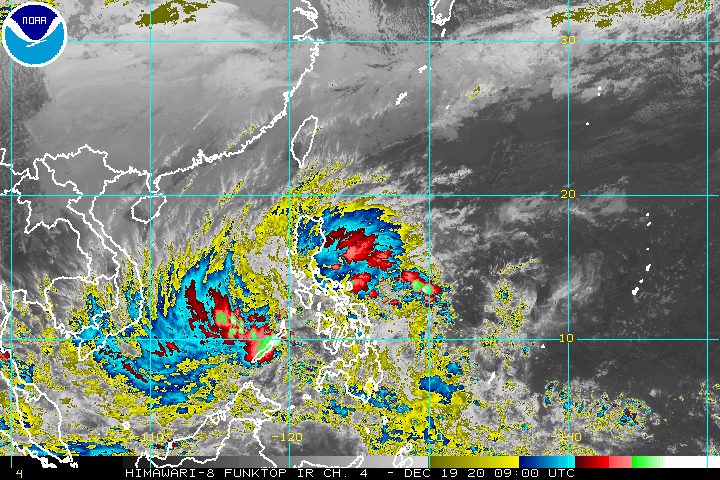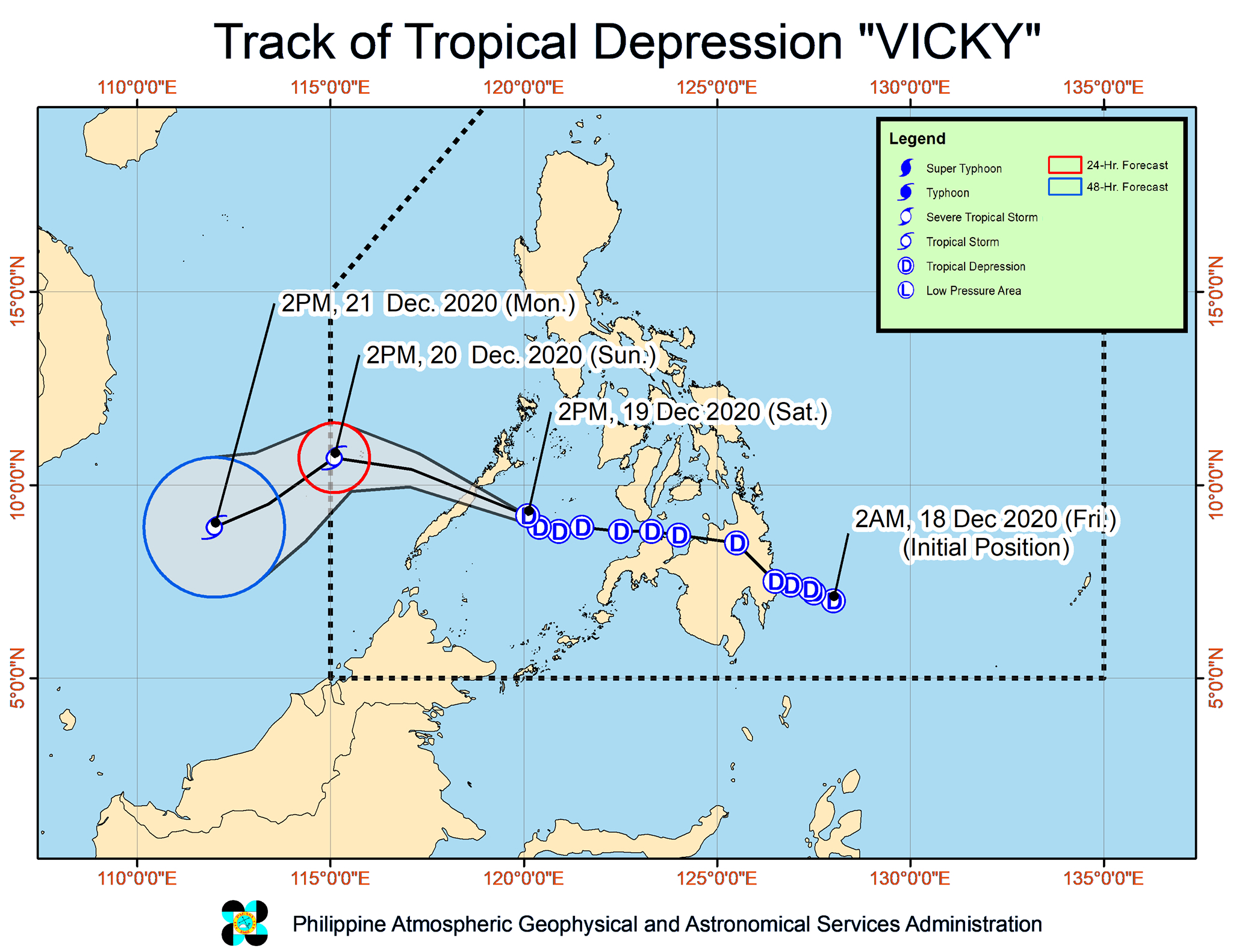SUMMARY
This is AI generated summarization, which may have errors. For context, always refer to the full article.

As Tropical Depression Vicky approaches Palawan, the tail-end of a frontal system continues to affect Southern Luzon while the northeast monsoon or hanging amihan is still affecting Northern Luzon and Central Luzon.
These 3 weather systems have all been bringing rain on Saturday, December 19.
In its 5 pm bulletin on Saturday, the Philippine Atmospheric, Geophysical, and Astronomical Services Administration (PAGASA) said Vicky is now 135 kilometers east southeast of Puerto Princesa City, Palawan.
The tropical depression slightly slowed down again, now moving west northwest at 15 kilometers per hour (km/h) from the previous 20 km/h.
It is still expected to make its 2nd landfall in the northern or central part of Palawan on Saturday evening, then emerge over the West Philippine Sea.
Vicky made its 1st landfall in Baganga, Davao Oriental, at 2 pm on Friday, December 18, then crossed parts of Mindanao before emerging over the Bohol Sea and subsequently the Sulu Sea. It caused massive floods in parts of Mindanao and the Visayas. (READ: #ReliefPH: Help communities affected by Tropical Depression Vicky)
As of early Saturday evening, Vicky continues to have maximum sustained winds of 45 km/h and gustiness of up to 55 km/h. It is likely to remain a tropical depression by the time it hits Palawan, but might strengthen into a tropical storm over the West Philippine Sea. (READ: FAST FACTS: Tropical cyclones, rainfall advisories)
Below is PAGASA’s latest rainfall outlook for Vicky, the tail-end of a frontal system, and the northeast monsoon. Affected areas are still at risk of floods and landslides.
Until Saturday evening, December 19
Moderate to heavy rain, with at times intense rain
- Bicol
- Isabela
- Aurora
- Laguna
- Rizal
- Quezon
- Marinduque
- Palawan including Calamian, Cuyo, and Cagayancillo Islands
- Eastern Visayas
Light to moderate rain, with at times heavy rain
- rest of mainland Cagayan Valley
- rest of Central Luzon
- rest of Calabarzon
- rest of Mimaropa
- Metro Manila
- Cordillera Administrative Region
- Visayas
Sunday, December 20
Heavy to intense rain
- Bicol
- Quezon
- Aurora
- Isabela
- Quirino
- Nueva Vizcaya
Moderate to heavy rain, with at times intense rain
- rest of mainland Cagayan Valley
- Apayao
- Kalinga
- Mountain Province
- Ifugao
- Oriental Mindoro
- Kalayaan Islands
Light to moderate rain, with at times heavy rain
- rest of Cordillera Administrative Region
- rest of Calabarzon
- rest of Mimaropa
- Metro Manila
- Bulacan
- Eastern Visayas
- Dinagat Islands
In terms of wind, Signal No. 1 remains raised in the northern and central parts of Palawan (Araceli, Dumaran, Taytay, El Nido, San Vicente, Roxas, Puerto Princesa City, Aborlan, Narra, Quezon, Sofronio Española), including Calamian, Cuyo, Cagayancillo, and Kalayaan Islands. Vicky is bringing “strong breeze to near gale conditions.”
Most parts of Luzon and the Visayas may also experience gusty conditions due to the surge of the northeast monsoon, according to PAGASA.
Sea travel will also remain risky in the next 24 hours because of Vicky and the surge of the northeast monsoon.
Rough to very rough seas (waves 2.5 to 4.5 meters high)
- entire seaboards of Northern Luzon
- seaboard of Aurora
- eastern seaboard of Quezon including Polillo Islands
- seaboard of Camarines Norte
- northern seaboard of Camarines Sur
- northern and eastern seaboards of Catanduanes
- eastern seaboard of Albay including Rapu-Rapu Islands
- eastern seaboard of Sorsogon
- northern and eastern seaboards of Northern Samar
- eastern seaboard of Eastern Samar including Homonhon Island
- eastern seaboard of Dinagat Islands
- eastern seaboard of Surigao del Norte
- seaboard of Surigao del Sur
- eastern seaboard of Davao Oriental
Moderate to rough seas (waves 2 to 4 meters high)
- coastal waters of areas under Signal No. 1
- seaboards of Agusan del Norte, Camiguin, Misamis Oriental, Lanao del Norte, and Misamis Occidental
- remaining seaboards of Luzon, Visayas, Surigao del Norte, Dinagat Islands, and Zamboanga del Norte
Vicky is expected to leave the Philippine Area of Responsibility (PAR) on Sunday afternoon, December 20.

Vicky is the Philippines’ 22nd tropical cyclone for 2020 – exceeding the yearly average of 20 – and the 1st for December. (READ: LIST: PAGASA’s names for tropical cyclones in 2020)
For December 2020 and January-June 2021, these are PAGASA’s estimates for tropical cyclones inside PAR:
- December 2020 – 1 or 2
- January 2021 – 0 or 1
- February 2021 – 0 or 1
- March 2021 – 0 or 1
- April 2021 – 0 or 1
- May 2021 – 0 or 1
- June 2021 – 1 or 2
La Niña has been underway since October, causing more rain than usual in the country. – Rappler.com
Add a comment
How does this make you feel?




There are no comments yet. Add your comment to start the conversation.